This article provides information as it was briefed to the Commission on May 23, 2003. It complements the article “NORAD’s Sudoku Puzzle; a failure to tell the truth,” which should be read first. In that article you were introduced to Colonel Scott, USAF, retired. It is Colonel Scott who presented the briefing to the Commission. The video of that briefing is available on the Commission’s web site; it does not, however, clearly show the briefing charts used. The charts have recently been made available by NARA and the purpose of this addendum is to share them.
Colonel Scott made it very clear that times on his charts were derived solely from logs, primarily the NEADS MCC/T log; no other source. It is understandable, then, why he would brief a Pentagon impact time of 8:43, for example, as opposed to the actual time. On the other hand, it does not make clear why he would show UA93 impacting near Pittsburgh, as show on his introductory chart.
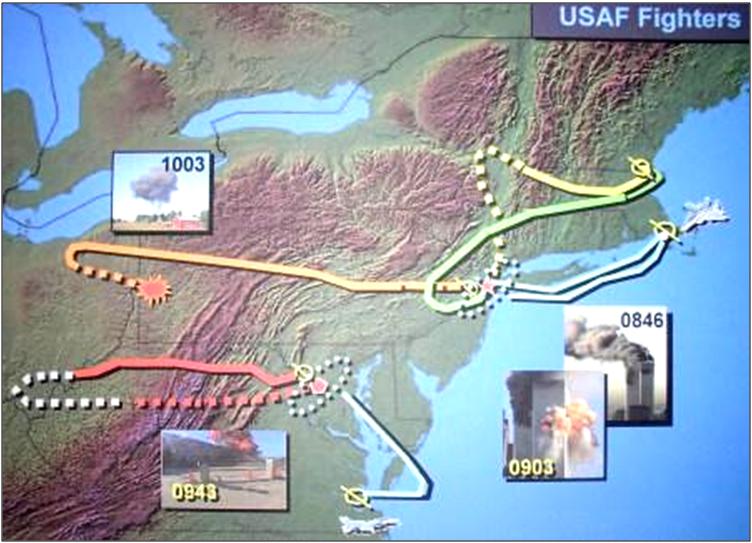
More important, however, is his treatment of the flight path of the Otis fighters and to some extent, the flight path of the Langley fighters as they neared the capital. Scott gave the impression that the Otis fighters hugged the coast and proceeded directly to New York City, consistent with the account given by the pilots during interviews in 2002. When asked during an interview at CONR why he blurred the scramble path Scott claimed limitations of the Powerpoint program, a disingenuous answer, at best.
The rest of Scott’s charts were timelines, included here for the record. Better renditions will become available when paper copies in Team 8, Box 8 at NARA are uploaded.
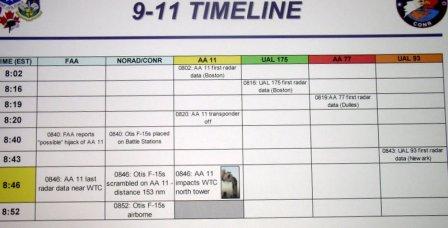

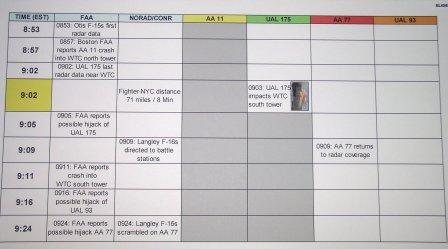
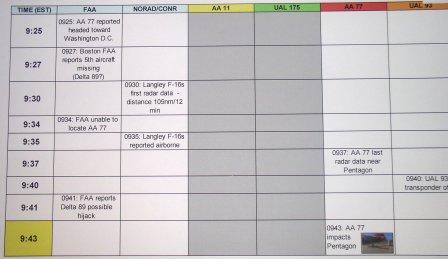
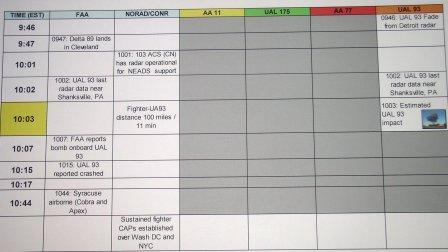

See the May 23, 2003 hearing article for a discussion of the discrepancies. In sum, NORAD read the MCC/T log wrong, twice; first when they prepared their Sep 18, 2001 press release and again when they prepared for the first air defense hearing. In my interviews with both Michael Bronner and Phil Shenon I attributed this to shoddy staff work, primarily at NEADS, which was not adequately vetted at either CONR (Generals Arnold and McKinley) or NORAD (General Eberhart).
The NORAD staff had clear and explicit information available; the radar files, the tapes, and the logs of the day. On September 25, 2001, in a memo to the US Space Command Directorate of Analysis the 84th RADES included an analysis of radar data for 11 Sep 2001 which included radar text files and Powerpoint slides showing flight paths. On June 3, 2002, a NORAD analyst, Cheri Gott made a presentation to the annual Satellite Toolkit (STK) Conference which was based on 84th RADES data. Moreover, she followed that with a May 13, 2003, briefing to CONR just 10 days prior to the first Commission hearing on air defense. A purpose of Gott’s staff work was to produce a product for the CINC (Gen Eberhart) to use from a Headquarters perspective. Relevant Gott source material is in Team 8, Box 8 at NARA.
NORAD’s failure to provide an accurate accounting of the day is inexcusable for any staff and particularly for a staff that had been at the air defense business for decades. NORAD failed to accurately read its own logs, tapes and radar files. Together with FAA it failed to reach agreement on the basic facts of the day in the immediate aftermath when events were fresh. The NORAD staff failed to adequately prepare its CINC for questions it knew were coming during General Eberhart’s annual testimony to Congress. Ultimately, NORAD failed to tell the story of the valiant battle by Alpha and Delta flights at NEADS; a story that General Arnold conceded was better than the one they did tell. Thanks to Michael Bronner that story has been told.

One thought on “9-11: NORAD’s Sudoku Puzzle; a briefing askew, an addendum”
Comments are closed.